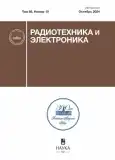Dual-polarization ultra-wideband metal-dielectric horn feed
- Autores: Kaloshin V.A.1, Nguyen T.2
-
Afiliações:
- Kotelnikov Institute of Radio Engineering and Electronics of the Russian Academy of Sciences
- Moscow Institute of Physics and Technology (National Research University)
- Edição: Volume 69, Nº 10 (2024)
- Páginas: 954-959
- Seção: АНТЕННО-ФИДЕРНЫЕ СИСТЕМЫ
- URL: https://rjsvd.com/0033-8494/article/view/684746
- DOI: https://doi.org/10.31857/S0033849424100036
- EDN: https://elibrary.ru/HQLRPA
- ID: 684746
Citar
Texto integral
Resumo
A dual-polarization ultra-wideband feed in the form of a metal four-ridge conical horn with a conical two-layer dielectric insert is proposed and investigated. Electrodynamic modeling and optimization of the transition parameters are carried out using finite element and finite difference methods in the time domain. It is shown that the proposed feed provides matching below the level of -10 dB in the frequency band of 6...40 GHz and the efficiency of a single-mirror offset system of more than 0.5 in the frequency band of 6...30 GHz.
Palavras-chave
Texto integral
Sobre autores
V. Kaloshin
Kotelnikov Institute of Radio Engineering and Electronics of the Russian Academy of Sciences
Autor responsável pela correspondência
Email: vak@cplire.ru
Rússia, ul. Mokhovaya, 11, building 7, Moscow, 125007
The Thanh Nguyen
Moscow Institute of Physics and Technology (National Research University)
Email: vak@cplire.ru
Rússia, Institutsky per., 9, Dolgoprudny, Moscow region, 141700
Bibliografia
- Akgiray A., Weinreb S., Imbriale W. //Proc. 2011 IEEE Int. Symp. on Antennas and Propagation. Spokane. 03-08 Jul. N.Y.:IEEE, 2011. P. 1135.
- Akgiray A., Weinreb S. // Proc. 2012 IEEE Int. Conf. on Ultra-Wideband. Syracuse. 17-20 Sept. N.Y.: IEEE, 2012. P. 518.
- Solak B., Secmen M., Tekin A. // Appl. Comp. Electromagnetics Soc. J. 2018. V. 33. № 9. P. 1009.
- Dong Bin, Yang Jian, Dahlstrom J. et al. // IEEE Trans. 2019. V. АР-67. № 1. P. 585.
- Ma Yue, Hwang C.S., Pang F. et al. // IEEE Access. 2020. V. 8. Article No. 81101.
- Dunning A., Bowen M., Bourne M. et al. // Proc. 2015 IEEE-APS Topical Conf. on Antennas and Propagation for Wireless Commun. (APWC). Turin. 07-11 Sept. N.Y.:IEEE, 2015. P. 787.
- Flygare J., Pantaleev M., Olvhammar S. // Proc. 12th Europ. Conf. on /ntennas and Propagtion (EuCAP 2018). London. 09-13 Apr.N.Y.:IEEE, 2018.Paper No. 0817.
- Flygare J., Pantaleev M. // IEEE Trans. 2020. V. АР-68. № 1. P. 207.
- Flygare J., Jang Jian., Pollak A.W. et al. // IEEE Trans. 2023. V. АР-71. № 3. P. 2110.
- Калошин В.А., Фам В.Ч. // РЭ. 2021. Т. 66. № 7. С. 649.
Arquivos suplementares



















